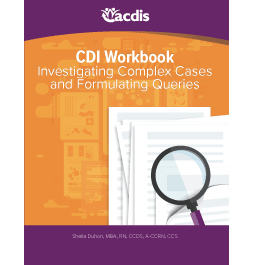Summer reading: Malnutrition documentation

Cases and Formulating Queries
By Sheila Duhon, MBA, RN, CCDS, A-CCRN, CCS
In April 2012, the Academy of Nutrition and Dietetics and the American Society for Parenteral and Enteral Nutrition (ASPEN) jointly published a consensus statement commonly referred to as the ASPEN paper. The consensus statement is considered by many to be the leading reference in assessing adult malnutrition, but it is not universally accepted so debate continues across the healthcare continuum.
In the paper, ASPEN asserts that:
Adult malnutrition is a common but frequently unrecognized problem whose incidence and prevalence are difficult to determine. In 1996, The Joint Commission mandated that nutrition screening be accomplished within 24 hours of admission. This resulted in the identification of multiple criteria and the development of a number of different approaches to the identification of malnutrition in hospitalized patients that were not always evidence based. Thus, there is currently no single, universally accepted approach to the diagnosis and documentation of adult malnutrition.
The following can serve as clinical indicators for a malnutrition query or may provide the impetus to looker deeper in the record for more information:
- Weight loss
- Diminished muscle mass, subcutaneous fat loss
- Impaired wound healing
- Temporal wasting
- Body mass index (BMI) of less than 19; however, it is important to note that malnutrition may occur at any BMI, not just below 19. A patient who is obese can still suffer from malnutrition when protein calorie intake is insufficient to meet the demands of the body.
- Feeding tube, supplemental feedings, parenteral nutrition
- Dry, thin skin with poor turgor
- Dry brittle nails and hair
- Loss of skin pigmentation
- Anemia
- Chronic diseases
- Generalized fluid accumulation or edema that could mask weight loss
- Dietary consult and all associated notes, insufficient protein calorie intake
- Depression, apathy, weakness, cachexia, diminished hand grip strength
- Serum albumin and pre-albumin are not diagnostic criteria for malnutrition (These are proteins that will reflect a decrease when faced with trauma, burns, or SIRS)
A word of caution about the malnutrition code E40, Kwashiorkor: This condition is extremely rare in a developed country such as the United States and should be used very judiciously, if at all. A 2019 article in CDI Strategies (ACDIS’ weekly free electronic newsletter) notes that, “The diagnosis of malnutrition has long been in the sights of the Office of Inspector General (OIG) for audits and denials. In fact, just as recently as December 2017, the OIG found that of 2,145 inpatient claims from 2006–2014 at 25 providers, all but one incorrectly included the diagnosis code for kwashiorkor. This resulted in overpayments in excess of $6 million.”
Editor’s note: This article is an excerpt from CDI Workbook: Investigating Complex Cases and Formulating Queries.
